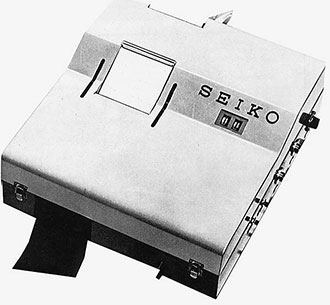Printing Timer
The first electronic recording system for sporting events, measurable to 1/1000 seconds
September 1963

Model I
Accuracy: 2 x 10-6
Reading accuracy: 0.002 sec.
Range of continuous printing: 9 hours 59 minutes 59 seconds 99
Interval in continuous printing: 0.02 sec.
Input terminal: Start, finish
Output terminal: Photo-finish use (1), Large clock for spectator use (1)
Power: AC 100V, DC 12V (10 hours)
The Printing Timer electronic recording system was developed for sporting event. Linked to a pistol, a phototube, and photo-finish equipment, the printing timer was able to automatically time events from start to finish. Moreover, it revolutionized time keeping as it was able to print the record simultaneously. The merits of this were demonstrated mainly in track and field, rowing, horseracing, swimming, cycling, and other events where it was difficult to make judgments using the naked eye or a stopwatch.
A highly accurate quartz clock was used in the time measurement mechanism. The time counter received an electronic time signal from the crystal oscillator and would begin counting from the start signal. When a lap or finish signal came, an electromagnetic hammer went into action and the printing mechanism printed the time to the nearest 0.01 second (though the timer was actually measuring down to the nearest 0.001 second). The ranking, course, and number of laps were also printed onto the internal paper roll. Moreover, these devices could also be linked to large clocks for the sake of the spectators. The system received praise at sporting events held throughout the world.
The development of this printing timer was the break that led to the development of the EP-101 digital printer that, in turn, became the origin of the Epson name.


